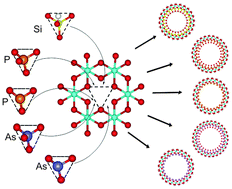Imogolite-like nanotubes: structure, stability, electronic and mechanical properties of the phosphorous and arsenic derivatives†
Abstract
Imogolite is a single-walled aluminosilicate

* Corresponding authors
a
Department of Natural Science, Universidade Federal de São João Del Rei, São João Del Rei, MG, Brazil
E-mail:
lucianaguimaraes@ufsj.edu.br
b
Department of Chemistry, ICEx, Universidade Federal de Minas Gerais, 31.270-901 Belo Horizonte, MG, Brazil
E-mail:
duarteh@ufmg.br
Imogolite is a single-walled aluminosilicate

 Please wait while we load your content...
Something went wrong. Try again?
Please wait while we load your content...
Something went wrong. Try again?
L. Guimarães, Y. N. Pinto, M. P. Lourenço and H. A. Duarte, Phys. Chem. Chem. Phys., 2013, 15, 4303 DOI: 10.1039/C3CP44250K
To request permission to reproduce material from this article, please go to the Copyright Clearance Center request page.
If you are an author contributing to an RSC publication, you do not need to request permission provided correct acknowledgement is given.
If you are the author of this article, you do not need to request permission to reproduce figures and diagrams provided correct acknowledgement is given. If you want to reproduce the whole article in a third-party publication (excluding your thesis/dissertation for which permission is not required) please go to the Copyright Clearance Center request page.
Read more about how to correctly acknowledge RSC content.
 Fetching data from CrossRef.
Fetching data from CrossRef.
This may take some time to load.
Loading related content
